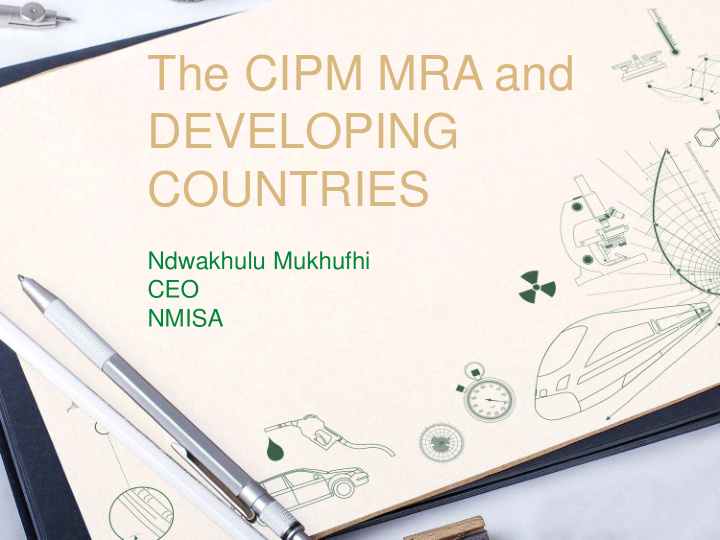



The CIPM MRA and DEVELOPING COUNTRIES Ndwakhulu Mukhufhi CEO NMISA
Outlay • The Situation before the CIPM MRA • Development of Metrology in Africa • The role of Developing and Upcoming NMIs • The View of the NMISA
the 43 members (end 2014) 2000 2015 -14 Members -44 Members -5 Associates -6 Associates
Members of the BIPM and Associates of the CGPM 2000 2015
Scientific Metrology Categorisation 2000 2015 AFRIMETS Key and Supplementary Comparisons Piloted and CMCs 2015 2007 KCs/SKs = 19 KCs/SKs = 1 CMCs CMCs = 121 = 451 High Level Metrology facilities (Member of the BIPM and participating in CCs and CIPM MRA) Established Metrology facilities, leading sub-RMO and participating in RMO comparisons (Associate of the CGPM) Established Metrology facilities, participating in RMO Comparisons (Associate of the CGPM / in the process to join) Basic Scientific/Industrial metrology facilities and Member of AFRIMETS No Scientific/Industrial Metrology facilities
The Importance For South Africa of International Acceptance of Measurements South African Alerts/ notifications/border rejections from EU 01/01/2010 - 01/03/2014 received from the European Commission Rapid Alert System for food and feed (RASFF) Parasitic Infestation 3% Composition Organoleptic properties Adulteration 3% 3% 1% Pathogenic microorganisms 3% Unauthorised food additives 4% Heavy metals 4% Poor controls (temperature) 5% Mycotoxins Pesticide residues 57% 17%
Benefits of the CIPM MRA for Developing Countries Development of Measurement capability • “Marketing” of the CIPM MRA in Africa had a positive influence on governments. For example the Kenyan government approved funding for metrology in Chemistry and biochemistry shortly after a CIPM MRA workshop in Kenya • The information flow from the JCRB and CCs to the RMO TCs greatly assists in the identification of measurement gaps in national metrology systems and the development of measurement capabilities
Benefits of the CIPM MRA for Developing Countries Total Quality Management Systems • The requirements of the CIPM MRA for a Quality system in support of CMCs greatly increased the focus on the implementation of quality systems based on ISO 17025 and related standards/guides in African NMIs
Benefits of the CIPM MRA for Developing Countries Harmonisation between Regions • Before the CIPM MRA very little harmonisation of procedures etc. exists between the different regions in the world. The JCRB introduced harmonisation of the review of QS, etc.
Benefits of the CIPM MRA for Developing Countries Acceptance of country measurement capabilities • The KCDB made it easier to identify calibration capabilities of other NMIs and with the ILAC agreement, creates a system whereby the calibration certificates and certificates of analysis can be accepted amongst trading partners in sub-regions
The NMISA view to make the CIPM MRA sustainable • Reduce number of Comparisons and CMCs through the SMART principle. NMISA is piloting 15 RMO Comparisons • Streamline the review process • First responsibility to ensure the correctness of CMCs and keep updated is with the NMI • QS is the responsibility of the NMI, reduce policing • Second responsibility is with the RMO, reduce inter-RMO review • Make better use of Comparison results • Use for certification of RMs? • The RMO comparisons should cater for institutes with lower capabilities • Reduce the burden on the main NMIs • Should we look at RMO legal metrology level CMCs?
“To Measure is to know”
Recommend
More recommend